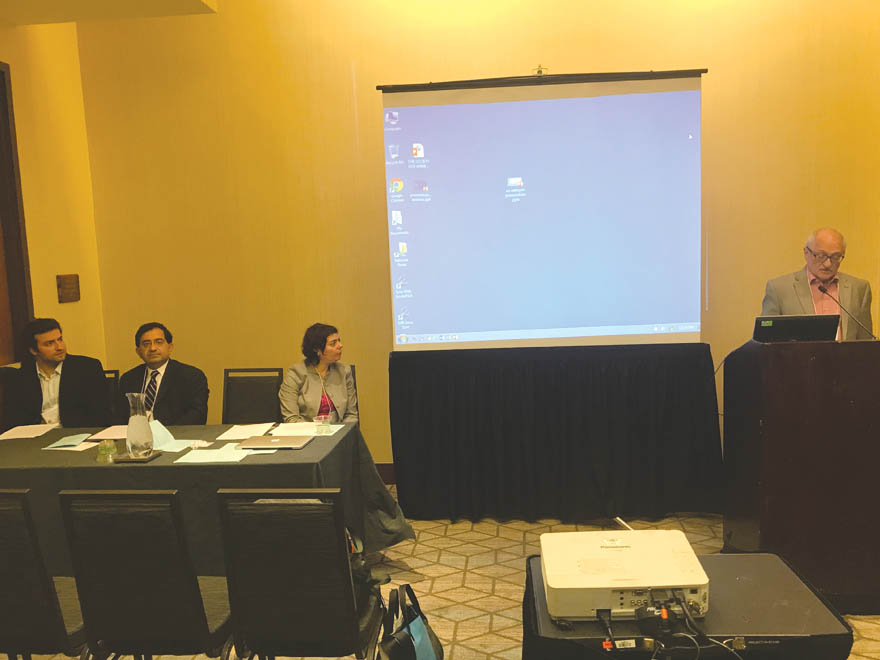
Mugrdechian, George Bournoutian, Vartan Matiossian, Sergio
La Porta, Bedross Der Matossian, Ari Şekeryan, Richard
Hovannisian, and Jakub Osiecki. Photo: ASP Archive
Staff Report
It was more than 100 years ago that an independent Republic of Armenia was established, the first Armenian state since the fall of the Kingdom of Cilicia in 1375. The Society for Armenian Studies organized an international conference, “Innovative Approa-ches to the History of the First Republic of Armenian, 1918-1920,” to mark this anniversary and to bring together scholars who would shed new light on the First Republic of Armenia.
The Conference, co-sponsored by the Armenian Communities Department of the Gulbenkian Foundation, took place on Thursday, November 15, 2018 in San Antonio, Texas. The SAS also held its Annual Membership meeting that same day, in conjunction with the Middle East Studies Association 52nd Annual Meeting.
SAS President Bedross Der Matossian (University of Nebraska, Lincoln) delivered the opening remarks at the conference. He stressed the significance of bringing together scholars to discuss important new research on the First Republic.
The Conference was organized into two sessions: “The First Republic in the International Context,” and “Gender, Person-alities, and Culture During the First Republic.”
The first session, chaired by Tsolin Nalbantian (Leiden University), consisted of three presentations. George Bournoutian (Iona College) spoke on “The Territorial Demands of the Armenian Republic: Reality versus Naiveté.” His comments focused on Armenian demands for land after the 1918 Mudros Armistice.

Bournoutian discussed the role of two Armenian representatives at the Peace Conference, Boghos Nubar Pasha and Avetis Aharonian, and their competing visions for the territory of a future Republic of Armenia. However, their vision competed with the interests of the Allies, especially France, which had already claimed Cilicia for itself. Bournoutian explained the difficult decisions faced by the Armenian representatives and the complexity of the changing political landscape. In the two years that it took to make a final settlement at the Treaty of Sevres, the realities on the ground had completely changed. The promises made by the Allies, in which the Armenians trusted, ended up unfulfilled.
Vartan Matiossian (Armenian National Education Committee, New York) spoke on “The Recognition of the First Republic of Armenia in South America (1918-1920).” Matiossian’s pre-sentation discussed the efforts of one Armenian, Etienne Brazil, to convince South American countries to recognize the Armenian Genocide in the aftermath of World War I. His efforts resulted in the recognition of Armenia by Brazil and Argentina in 1920, but the League of Nations ultimately rejected recognition of Armenia. Etienne Brazil served as a representative of the Republic of Armenia in South America, although there was at the time only a very small Armenian community in South America. His one-man efforts left a large impact.
Ari Şekeryan (University of Oxford) spoke on the topic of “Rethinking the Establishment of the First Republic of Armenia: Reactions of the Ottoman-Turkish and Armenian Press in Istanbul.”
Şekeryan utilized Armenian and Turkish newspaper from the period of May-October 1918, to illustrate his argument about the differing expectation between Turks and Armenians regarding the question of the Republic of Armenia. The Armenians in Istanbul wanted to regain the trust of the Turks, by publishing articles that expressed their fidelity to the Turkish state. For the Turks, it was a question of what they may lose in the establishment of the Republic of Armenia.
The second session, entitled “Gender, Personalities, and Culture during the First Republic,” was chaired by Barlow Der Mugrdechian (California State University, Fresno). The session included two presentations.
Seda D. Ohanian (National Academy of Science of Armenia) discussed “Armenian Women in the Parliament of the First Republic (1918-1920).” Her talk shed light on the little researched fact that three women served in the first parliament of the Republic of Armenia. Ohanian gave an overview of these women and their accomplishments.
One woman, Katarina Zalian Manoogian made a significant impact in the life of the Republic. This was at a time when in the United States women still did not have the right to vote. Ohanian also discussed the Parliament of the modern Republic of Armenia, arguing that although progress is being made in including more women, there is more work to be done.
The final presentation was by Jakub Osiecki (Jagiellonian University in Krakow), who spoke on “The Trip of Apostolic Visitor rev. Antonio Delpuche to Yerevan as the Attempt to Establish Diplomatic Relations between the Republic of Armenia and the Vatican.” Osiecki’s paper focused on relations between the Catholic Church and the Armenian Apostolic Church in the period of the early twentieth century. Statistics indicate there were some 66,618 Armenian Catholics and 45 Armenian rite churches in the Republic of Armenia in 1920. While this may seem significant, in reality Armenia was isolated by Georgia and Azerbaijan. The only visit of a high-ranking Catholic clergyman to Armenia in this period was the result of having been officially invited to Georgia Osiecki discussed the visit to Armenia by the Vatican representative Antonio Delpuche.
Richard G. Hovannisian (UCLA, USC, and Chapman University) was invited to offer concluding remarks at the Conference.
Dr. Hovannisian pointed out that the study of the First Republic of Armenia is now entering a new phase as new insight is being provided by scholars.
Hovannisian, the author of a four-volume history of the Republic of Armenia, emphasized how the study of the Republic has changed over the years. Hovannisian encouraged scholars to continue to reevaluate the Republic of Armenia in light of new archival sources.
The Society for Armenian Studies represents scholars and teachers in the field of Armenian Studies.
The aims of the SAS are to promote the study of Armenian culture and society; to facilitate the exchange of scholarly information pertaining to Armenian studies around the world; and to sponsor panels and conferences on Armenian studies. It publishes the peer-reviewed Journal of the Society for Armenian Studies, available on its website: societyforarmenianstudies.com.
 Hye Sharzhoom Armenian Action
Hye Sharzhoom Armenian Action